Business Ethics, Responsibility and Sustainability in Clothing Industry
VerifiedAdded on 2023/06/08
|13
|3996
|264
AI Summary
This report discusses the interlink between business ethics, responsibility and sustainability in the clothing industry. It examines the key challenges related to corporate responsibility and sustainability, analyses the best practices for the clothing industry in context to the moral and ethical issues, and provides recommendations for businesses in the clothing industry to show their responsibility towards global considerations. The report also highlights the importance of adopting CSR initiatives for the clothing industry.
Contribute Materials
Your contribution can guide someone’s learning journey. Share your
documents today.
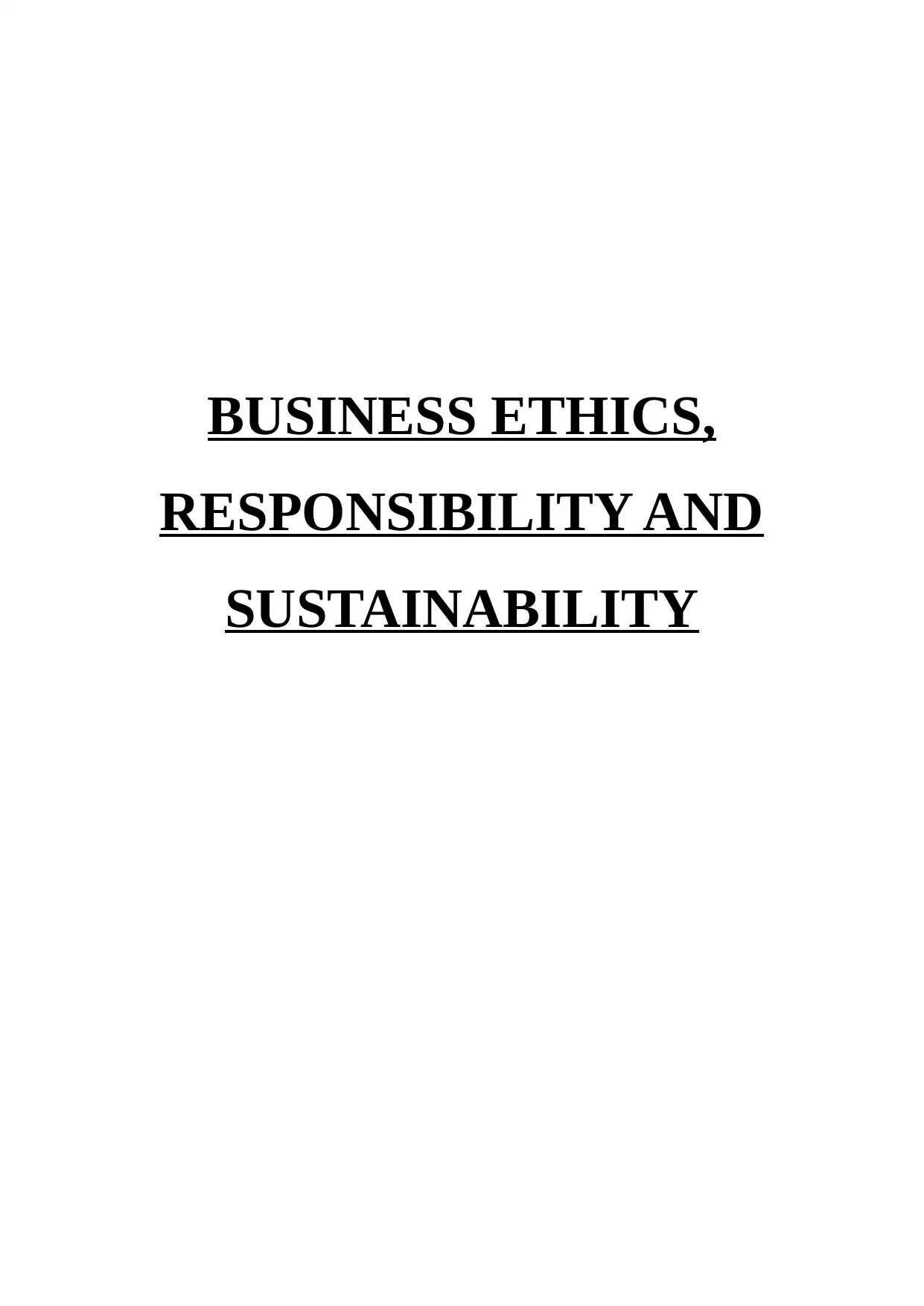
BUSINESS ETHICS,
RESPONSIBILITY AND
SUSTAINABILITY
RESPONSIBILITY AND
SUSTAINABILITY
Secure Best Marks with AI Grader
Need help grading? Try our AI Grader for instant feedback on your assignments.
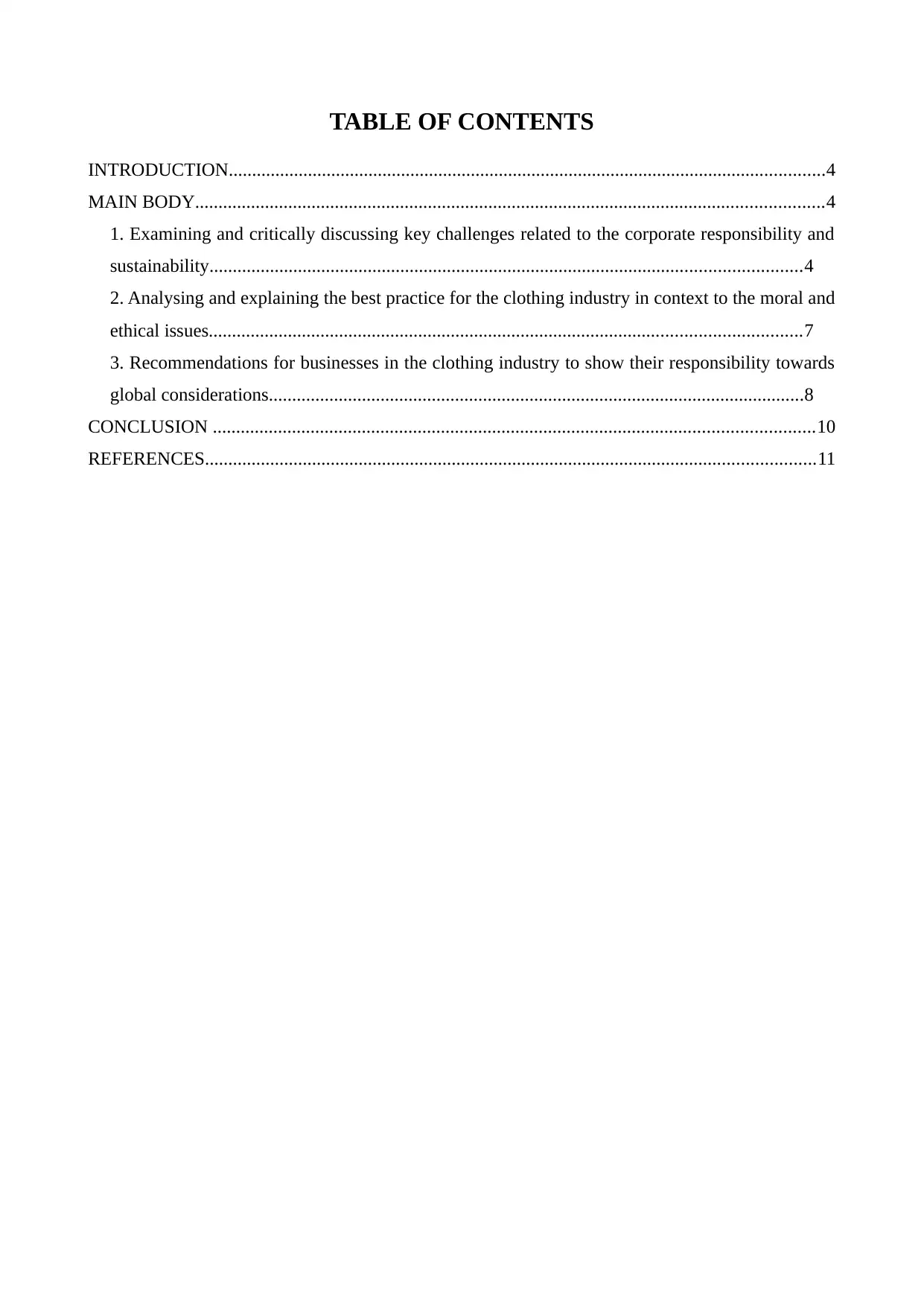
TABLE OF CONTENTS
INTRODUCTION................................................................................................................................4
MAIN BODY.......................................................................................................................................4
1. Examining and critically discussing key challenges related to the corporate responsibility and
sustainability...............................................................................................................................4
2. Analysing and explaining the best practice for the clothing industry in context to the moral and
ethical issues...............................................................................................................................7
3. Recommendations for businesses in the clothing industry to show their responsibility towards
global considerations...................................................................................................................8
CONCLUSION .................................................................................................................................10
REFERENCES...................................................................................................................................11
INTRODUCTION................................................................................................................................4
MAIN BODY.......................................................................................................................................4
1. Examining and critically discussing key challenges related to the corporate responsibility and
sustainability...............................................................................................................................4
2. Analysing and explaining the best practice for the clothing industry in context to the moral and
ethical issues...............................................................................................................................7
3. Recommendations for businesses in the clothing industry to show their responsibility towards
global considerations...................................................................................................................8
CONCLUSION .................................................................................................................................10
REFERENCES...................................................................................................................................11

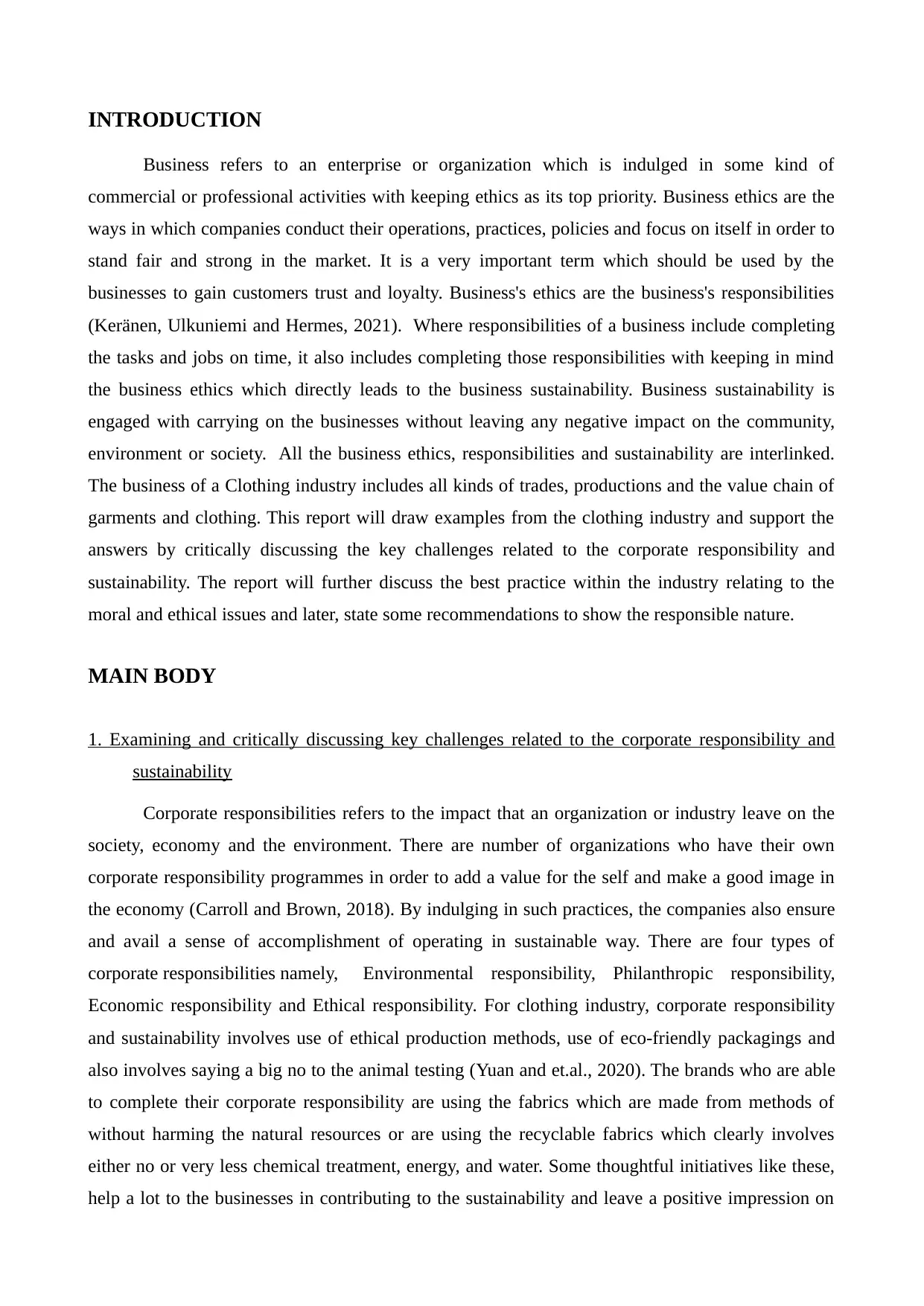
INTRODUCTION
Business refers to an enterprise or organization which is indulged in some kind of
commercial or professional activities with keeping ethics as its top priority. Business ethics are the
ways in which companies conduct their operations, practices, policies and focus on itself in order to
stand fair and strong in the market. It is a very important term which should be used by the
businesses to gain customers trust and loyalty. Business's ethics are the business's responsibilities
(Keränen, Ulkuniemi and Hermes, 2021). Where responsibilities of a business include completing
the tasks and jobs on time, it also includes completing those responsibilities with keeping in mind
the business ethics which directly leads to the business sustainability. Business sustainability is
engaged with carrying on the businesses without leaving any negative impact on the community,
environment or society. All the business ethics, responsibilities and sustainability are interlinked.
The business of a Clothing industry includes all kinds of trades, productions and the value chain of
garments and clothing. This report will draw examples from the clothing industry and support the
answers by critically discussing the key challenges related to the corporate responsibility and
sustainability. The report will further discuss the best practice within the industry relating to the
moral and ethical issues and later, state some recommendations to show the responsible nature.
MAIN BODY
1. Examining and critically discussing key challenges related to the corporate responsibility and
sustainability
Corporate responsibilities refers to the impact that an organization or industry leave on the
society, economy and the environment. There are number of organizations who have their own
corporate responsibility programmes in order to add a value for the self and make a good image in
the economy (Carroll and Brown, 2018). By indulging in such practices, the companies also ensure
and avail a sense of accomplishment of operating in sustainable way. There are four types of
corporate responsibilities namely, Environmental responsibility, Philanthropic responsibility,
Economic responsibility and Ethical responsibility. For clothing industry, corporate responsibility
and sustainability involves use of ethical production methods, use of eco-friendly packagings and
also involves saying a big no to the animal testing (Yuan and et.al., 2020). The brands who are able
to complete their corporate responsibility are using the fabrics which are made from methods of
without harming the natural resources or are using the recyclable fabrics which clearly involves
either no or very less chemical treatment, energy, and water. Some thoughtful initiatives like these,
help a lot to the businesses in contributing to the sustainability and leave a positive impression on
Business refers to an enterprise or organization which is indulged in some kind of
commercial or professional activities with keeping ethics as its top priority. Business ethics are the
ways in which companies conduct their operations, practices, policies and focus on itself in order to
stand fair and strong in the market. It is a very important term which should be used by the
businesses to gain customers trust and loyalty. Business's ethics are the business's responsibilities
(Keränen, Ulkuniemi and Hermes, 2021). Where responsibilities of a business include completing
the tasks and jobs on time, it also includes completing those responsibilities with keeping in mind
the business ethics which directly leads to the business sustainability. Business sustainability is
engaged with carrying on the businesses without leaving any negative impact on the community,
environment or society. All the business ethics, responsibilities and sustainability are interlinked.
The business of a Clothing industry includes all kinds of trades, productions and the value chain of
garments and clothing. This report will draw examples from the clothing industry and support the
answers by critically discussing the key challenges related to the corporate responsibility and
sustainability. The report will further discuss the best practice within the industry relating to the
moral and ethical issues and later, state some recommendations to show the responsible nature.
MAIN BODY
1. Examining and critically discussing key challenges related to the corporate responsibility and
sustainability
Corporate responsibilities refers to the impact that an organization or industry leave on the
society, economy and the environment. There are number of organizations who have their own
corporate responsibility programmes in order to add a value for the self and make a good image in
the economy (Carroll and Brown, 2018). By indulging in such practices, the companies also ensure
and avail a sense of accomplishment of operating in sustainable way. There are four types of
corporate responsibilities namely, Environmental responsibility, Philanthropic responsibility,
Economic responsibility and Ethical responsibility. For clothing industry, corporate responsibility
and sustainability involves use of ethical production methods, use of eco-friendly packagings and
also involves saying a big no to the animal testing (Yuan and et.al., 2020). The brands who are able
to complete their corporate responsibility are using the fabrics which are made from methods of
without harming the natural resources or are using the recyclable fabrics which clearly involves
either no or very less chemical treatment, energy, and water. Some thoughtful initiatives like these,
help a lot to the businesses in contributing to the sustainability and leave a positive impression on
Secure Best Marks with AI Grader
Need help grading? Try our AI Grader for instant feedback on your assignments.
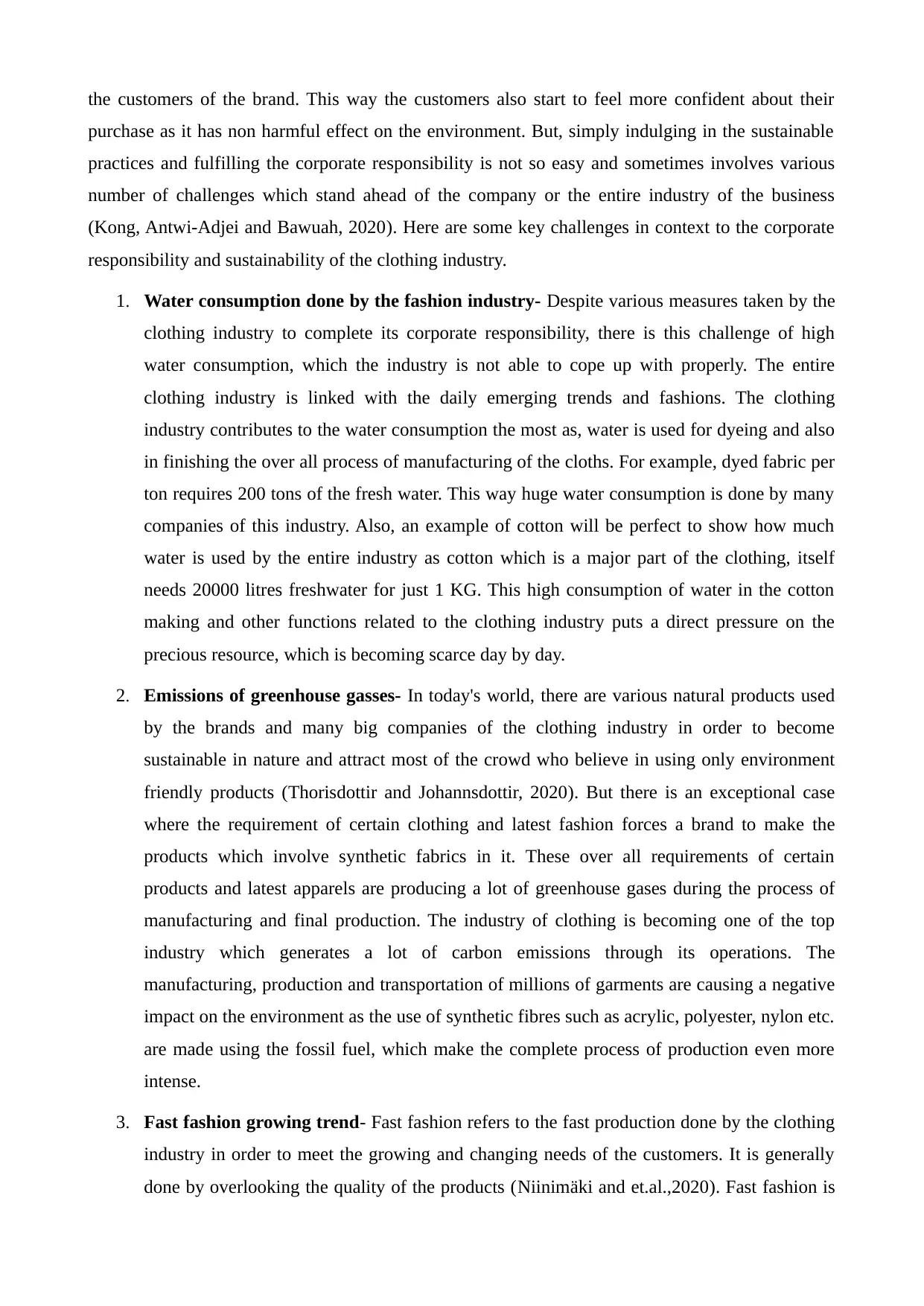
the customers of the brand. This way the customers also start to feel more confident about their
purchase as it has non harmful effect on the environment. But, simply indulging in the sustainable
practices and fulfilling the corporate responsibility is not so easy and sometimes involves various
number of challenges which stand ahead of the company or the entire industry of the business
(Kong, Antwi‐Adjei and Bawuah, 2020). Here are some key challenges in context to the corporate
responsibility and sustainability of the clothing industry.
1. Water consumption done by the fashion industry- Despite various measures taken by the
clothing industry to complete its corporate responsibility, there is this challenge of high
water consumption, which the industry is not able to cope up with properly. The entire
clothing industry is linked with the daily emerging trends and fashions. The clothing
industry contributes to the water consumption the most as, water is used for dyeing and also
in finishing the over all process of manufacturing of the cloths. For example, dyed fabric per
ton requires 200 tons of the fresh water. This way huge water consumption is done by many
companies of this industry. Also, an example of cotton will be perfect to show how much
water is used by the entire industry as cotton which is a major part of the clothing, itself
needs 20000 litres freshwater for just 1 KG. This high consumption of water in the cotton
making and other functions related to the clothing industry puts a direct pressure on the
precious resource, which is becoming scarce day by day.
2. Emissions of greenhouse gasses- In today's world, there are various natural products used
by the brands and many big companies of the clothing industry in order to become
sustainable in nature and attract most of the crowd who believe in using only environment
friendly products (Thorisdottir and Johannsdottir, 2020). But there is an exceptional case
where the requirement of certain clothing and latest fashion forces a brand to make the
products which involve synthetic fabrics in it. These over all requirements of certain
products and latest apparels are producing a lot of greenhouse gases during the process of
manufacturing and final production. The industry of clothing is becoming one of the top
industry which generates a lot of carbon emissions through its operations. The
manufacturing, production and transportation of millions of garments are causing a negative
impact on the environment as the use of synthetic fibres such as acrylic, polyester, nylon etc.
are made using the fossil fuel, which make the complete process of production even more
intense.
3. Fast fashion growing trend- Fast fashion refers to the fast production done by the clothing
industry in order to meet the growing and changing needs of the customers. It is generally
done by overlooking the quality of the products (Niinimäki and et.al.,2020). Fast fashion is
purchase as it has non harmful effect on the environment. But, simply indulging in the sustainable
practices and fulfilling the corporate responsibility is not so easy and sometimes involves various
number of challenges which stand ahead of the company or the entire industry of the business
(Kong, Antwi‐Adjei and Bawuah, 2020). Here are some key challenges in context to the corporate
responsibility and sustainability of the clothing industry.
1. Water consumption done by the fashion industry- Despite various measures taken by the
clothing industry to complete its corporate responsibility, there is this challenge of high
water consumption, which the industry is not able to cope up with properly. The entire
clothing industry is linked with the daily emerging trends and fashions. The clothing
industry contributes to the water consumption the most as, water is used for dyeing and also
in finishing the over all process of manufacturing of the cloths. For example, dyed fabric per
ton requires 200 tons of the fresh water. This way huge water consumption is done by many
companies of this industry. Also, an example of cotton will be perfect to show how much
water is used by the entire industry as cotton which is a major part of the clothing, itself
needs 20000 litres freshwater for just 1 KG. This high consumption of water in the cotton
making and other functions related to the clothing industry puts a direct pressure on the
precious resource, which is becoming scarce day by day.
2. Emissions of greenhouse gasses- In today's world, there are various natural products used
by the brands and many big companies of the clothing industry in order to become
sustainable in nature and attract most of the crowd who believe in using only environment
friendly products (Thorisdottir and Johannsdottir, 2020). But there is an exceptional case
where the requirement of certain clothing and latest fashion forces a brand to make the
products which involve synthetic fabrics in it. These over all requirements of certain
products and latest apparels are producing a lot of greenhouse gases during the process of
manufacturing and final production. The industry of clothing is becoming one of the top
industry which generates a lot of carbon emissions through its operations. The
manufacturing, production and transportation of millions of garments are causing a negative
impact on the environment as the use of synthetic fibres such as acrylic, polyester, nylon etc.
are made using the fossil fuel, which make the complete process of production even more
intense.
3. Fast fashion growing trend- Fast fashion refers to the fast production done by the clothing
industry in order to meet the growing and changing needs of the customers. It is generally
done by overlooking the quality of the products (Niinimäki and et.al.,2020). Fast fashion is
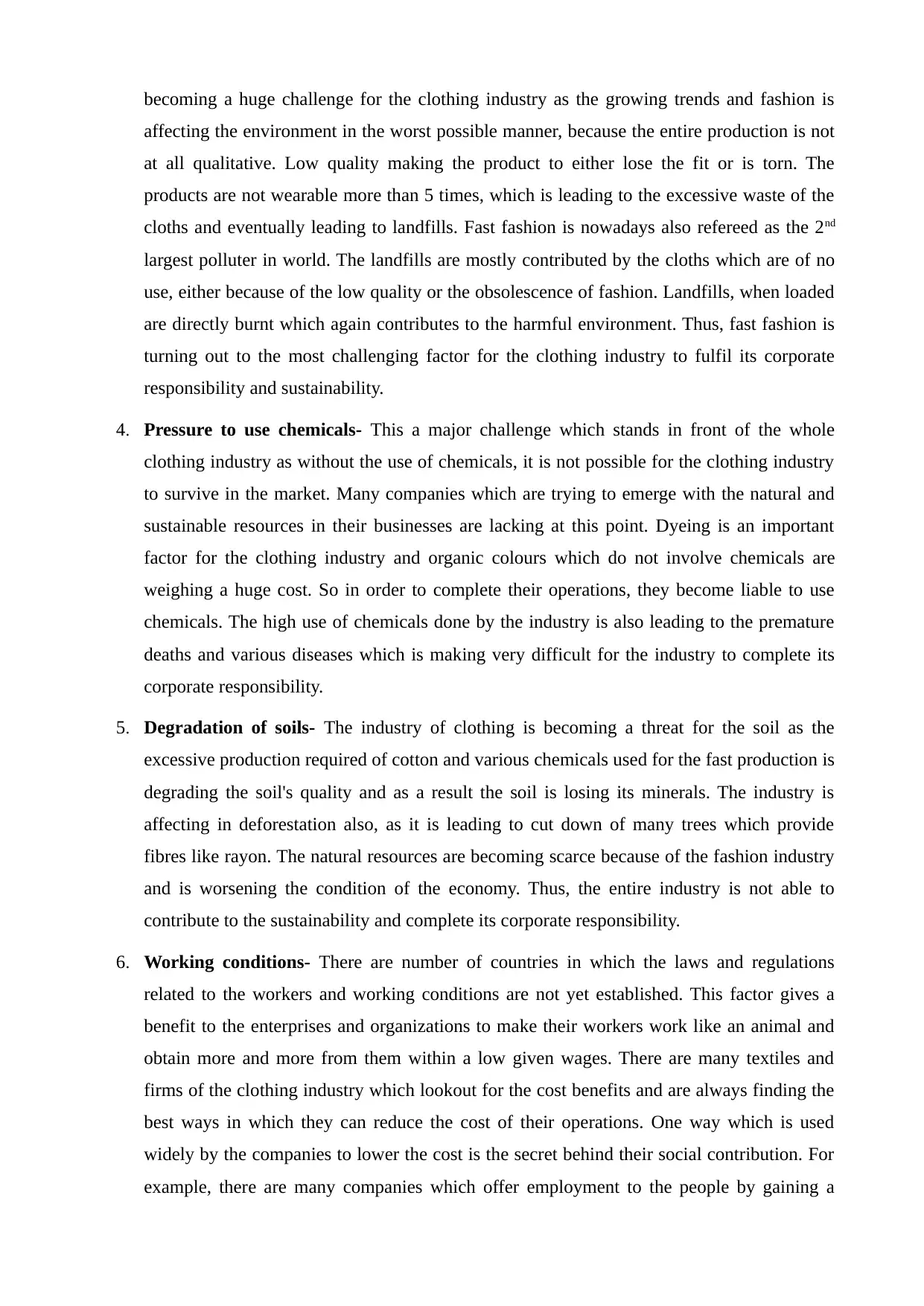
becoming a huge challenge for the clothing industry as the growing trends and fashion is
affecting the environment in the worst possible manner, because the entire production is not
at all qualitative. Low quality making the product to either lose the fit or is torn. The
products are not wearable more than 5 times, which is leading to the excessive waste of the
cloths and eventually leading to landfills. Fast fashion is nowadays also refereed as the 2nd
largest polluter in world. The landfills are mostly contributed by the cloths which are of no
use, either because of the low quality or the obsolescence of fashion. Landfills, when loaded
are directly burnt which again contributes to the harmful environment. Thus, fast fashion is
turning out to the most challenging factor for the clothing industry to fulfil its corporate
responsibility and sustainability.
4. Pressure to use chemicals- This a major challenge which stands in front of the whole
clothing industry as without the use of chemicals, it is not possible for the clothing industry
to survive in the market. Many companies which are trying to emerge with the natural and
sustainable resources in their businesses are lacking at this point. Dyeing is an important
factor for the clothing industry and organic colours which do not involve chemicals are
weighing a huge cost. So in order to complete their operations, they become liable to use
chemicals. The high use of chemicals done by the industry is also leading to the premature
deaths and various diseases which is making very difficult for the industry to complete its
corporate responsibility.
5. Degradation of soils- The industry of clothing is becoming a threat for the soil as the
excessive production required of cotton and various chemicals used for the fast production is
degrading the soil's quality and as a result the soil is losing its minerals. The industry is
affecting in deforestation also, as it is leading to cut down of many trees which provide
fibres like rayon. The natural resources are becoming scarce because of the fashion industry
and is worsening the condition of the economy. Thus, the entire industry is not able to
contribute to the sustainability and complete its corporate responsibility.
6. Working conditions- There are number of countries in which the laws and regulations
related to the workers and working conditions are not yet established. This factor gives a
benefit to the enterprises and organizations to make their workers work like an animal and
obtain more and more from them within a low given wages. There are many textiles and
firms of the clothing industry which lookout for the cost benefits and are always finding the
best ways in which they can reduce the cost of their operations. One way which is used
widely by the companies to lower the cost is the secret behind their social contribution. For
example, there are many companies which offer employment to the people by gaining a
affecting the environment in the worst possible manner, because the entire production is not
at all qualitative. Low quality making the product to either lose the fit or is torn. The
products are not wearable more than 5 times, which is leading to the excessive waste of the
cloths and eventually leading to landfills. Fast fashion is nowadays also refereed as the 2nd
largest polluter in world. The landfills are mostly contributed by the cloths which are of no
use, either because of the low quality or the obsolescence of fashion. Landfills, when loaded
are directly burnt which again contributes to the harmful environment. Thus, fast fashion is
turning out to the most challenging factor for the clothing industry to fulfil its corporate
responsibility and sustainability.
4. Pressure to use chemicals- This a major challenge which stands in front of the whole
clothing industry as without the use of chemicals, it is not possible for the clothing industry
to survive in the market. Many companies which are trying to emerge with the natural and
sustainable resources in their businesses are lacking at this point. Dyeing is an important
factor for the clothing industry and organic colours which do not involve chemicals are
weighing a huge cost. So in order to complete their operations, they become liable to use
chemicals. The high use of chemicals done by the industry is also leading to the premature
deaths and various diseases which is making very difficult for the industry to complete its
corporate responsibility.
5. Degradation of soils- The industry of clothing is becoming a threat for the soil as the
excessive production required of cotton and various chemicals used for the fast production is
degrading the soil's quality and as a result the soil is losing its minerals. The industry is
affecting in deforestation also, as it is leading to cut down of many trees which provide
fibres like rayon. The natural resources are becoming scarce because of the fashion industry
and is worsening the condition of the economy. Thus, the entire industry is not able to
contribute to the sustainability and complete its corporate responsibility.
6. Working conditions- There are number of countries in which the laws and regulations
related to the workers and working conditions are not yet established. This factor gives a
benefit to the enterprises and organizations to make their workers work like an animal and
obtain more and more from them within a low given wages. There are many textiles and
firms of the clothing industry which lookout for the cost benefits and are always finding the
best ways in which they can reduce the cost of their operations. One way which is used
widely by the companies to lower the cost is the secret behind their social contribution. For
example, there are many companies which offer employment to the people by gaining a
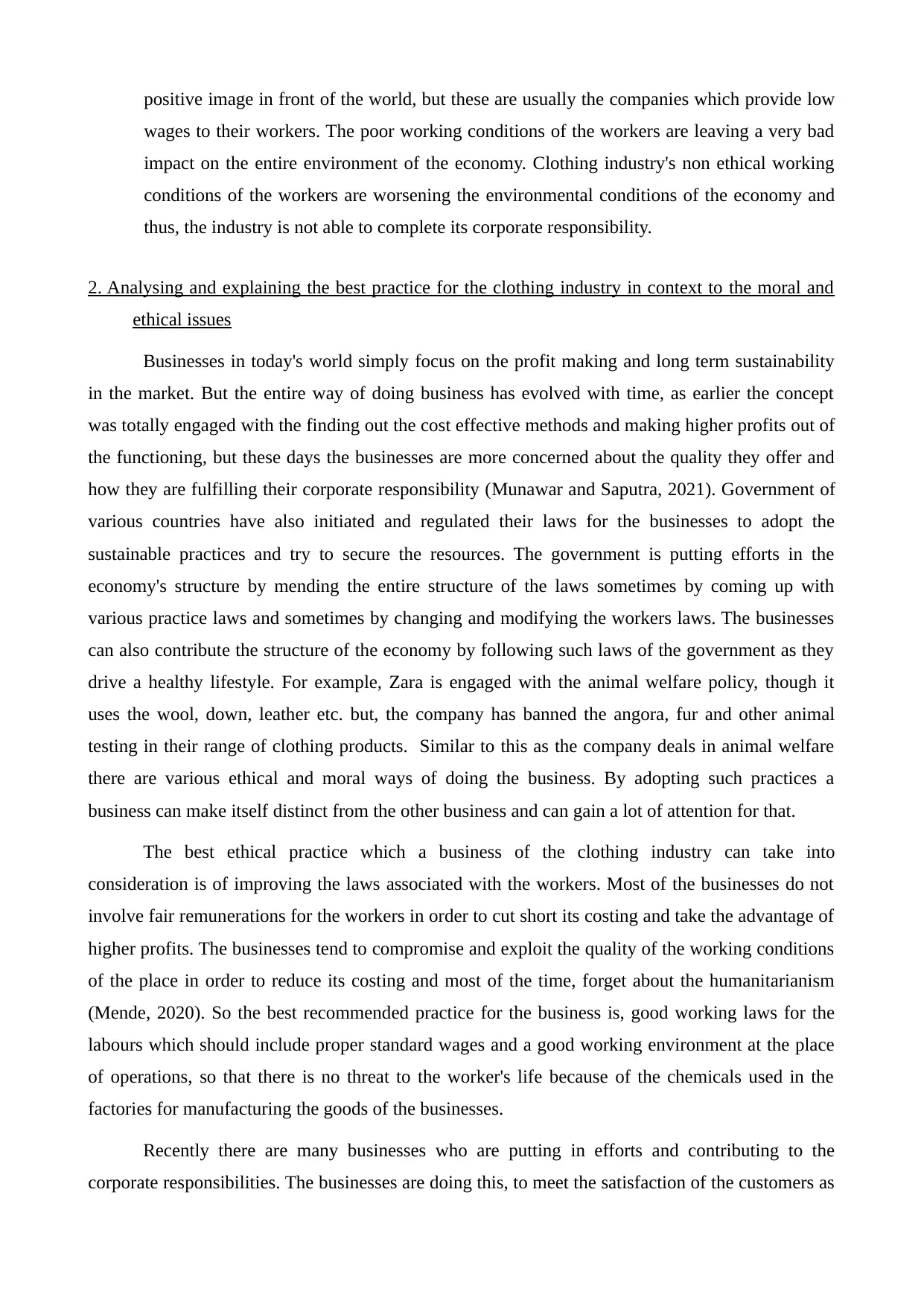
positive image in front of the world, but these are usually the companies which provide low
wages to their workers. The poor working conditions of the workers are leaving a very bad
impact on the entire environment of the economy. Clothing industry's non ethical working
conditions of the workers are worsening the environmental conditions of the economy and
thus, the industry is not able to complete its corporate responsibility.
2. Analysing and explaining the best practice for the clothing industry in context to the moral and
ethical issues
Businesses in today's world simply focus on the profit making and long term sustainability
in the market. But the entire way of doing business has evolved with time, as earlier the concept
was totally engaged with the finding out the cost effective methods and making higher profits out of
the functioning, but these days the businesses are more concerned about the quality they offer and
how they are fulfilling their corporate responsibility (Munawar and Saputra, 2021). Government of
various countries have also initiated and regulated their laws for the businesses to adopt the
sustainable practices and try to secure the resources. The government is putting efforts in the
economy's structure by mending the entire structure of the laws sometimes by coming up with
various practice laws and sometimes by changing and modifying the workers laws. The businesses
can also contribute the structure of the economy by following such laws of the government as they
drive a healthy lifestyle. For example, Zara is engaged with the animal welfare policy, though it
uses the wool, down, leather etc. but, the company has banned the angora, fur and other animal
testing in their range of clothing products. Similar to this as the company deals in animal welfare
there are various ethical and moral ways of doing the business. By adopting such practices a
business can make itself distinct from the other business and can gain a lot of attention for that.
The best ethical practice which a business of the clothing industry can take into
consideration is of improving the laws associated with the workers. Most of the businesses do not
involve fair remunerations for the workers in order to cut short its costing and take the advantage of
higher profits. The businesses tend to compromise and exploit the quality of the working conditions
of the place in order to reduce its costing and most of the time, forget about the humanitarianism
(Mende, 2020). So the best recommended practice for the business is, good working laws for the
labours which should include proper standard wages and a good working environment at the place
of operations, so that there is no threat to the worker's life because of the chemicals used in the
factories for manufacturing the goods of the businesses.
Recently there are many businesses who are putting in efforts and contributing to the
corporate responsibilities. The businesses are doing this, to meet the satisfaction of the customers as
wages to their workers. The poor working conditions of the workers are leaving a very bad
impact on the entire environment of the economy. Clothing industry's non ethical working
conditions of the workers are worsening the environmental conditions of the economy and
thus, the industry is not able to complete its corporate responsibility.
2. Analysing and explaining the best practice for the clothing industry in context to the moral and
ethical issues
Businesses in today's world simply focus on the profit making and long term sustainability
in the market. But the entire way of doing business has evolved with time, as earlier the concept
was totally engaged with the finding out the cost effective methods and making higher profits out of
the functioning, but these days the businesses are more concerned about the quality they offer and
how they are fulfilling their corporate responsibility (Munawar and Saputra, 2021). Government of
various countries have also initiated and regulated their laws for the businesses to adopt the
sustainable practices and try to secure the resources. The government is putting efforts in the
economy's structure by mending the entire structure of the laws sometimes by coming up with
various practice laws and sometimes by changing and modifying the workers laws. The businesses
can also contribute the structure of the economy by following such laws of the government as they
drive a healthy lifestyle. For example, Zara is engaged with the animal welfare policy, though it
uses the wool, down, leather etc. but, the company has banned the angora, fur and other animal
testing in their range of clothing products. Similar to this as the company deals in animal welfare
there are various ethical and moral ways of doing the business. By adopting such practices a
business can make itself distinct from the other business and can gain a lot of attention for that.
The best ethical practice which a business of the clothing industry can take into
consideration is of improving the laws associated with the workers. Most of the businesses do not
involve fair remunerations for the workers in order to cut short its costing and take the advantage of
higher profits. The businesses tend to compromise and exploit the quality of the working conditions
of the place in order to reduce its costing and most of the time, forget about the humanitarianism
(Mende, 2020). So the best recommended practice for the business is, good working laws for the
labours which should include proper standard wages and a good working environment at the place
of operations, so that there is no threat to the worker's life because of the chemicals used in the
factories for manufacturing the goods of the businesses.
Recently there are many businesses who are putting in efforts and contributing to the
corporate responsibilities. The businesses are doing this, to meet the satisfaction of the customers as
Paraphrase This Document
Need a fresh take? Get an instant paraphrase of this document with our AI Paraphraser
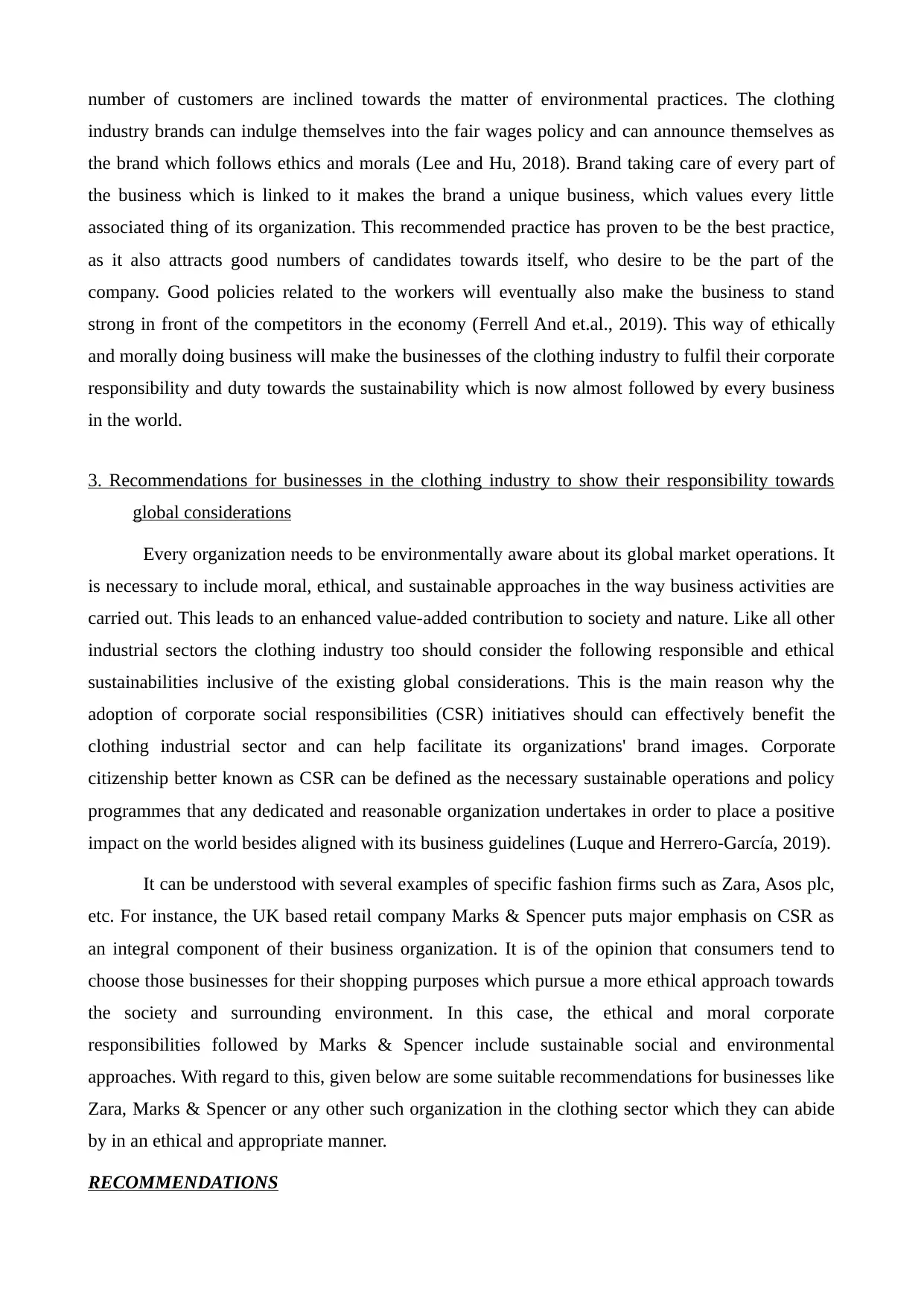
number of customers are inclined towards the matter of environmental practices. The clothing
industry brands can indulge themselves into the fair wages policy and can announce themselves as
the brand which follows ethics and morals (Lee and Hu, 2018). Brand taking care of every part of
the business which is linked to it makes the brand a unique business, which values every little
associated thing of its organization. This recommended practice has proven to be the best practice,
as it also attracts good numbers of candidates towards itself, who desire to be the part of the
company. Good policies related to the workers will eventually also make the business to stand
strong in front of the competitors in the economy (Ferrell And et.al., 2019). This way of ethically
and morally doing business will make the businesses of the clothing industry to fulfil their corporate
responsibility and duty towards the sustainability which is now almost followed by every business
in the world.
3. Recommendations for businesses in the clothing industry to show their responsibility towards
global considerations
Every organization needs to be environmentally aware about its global market operations. It
is necessary to include moral, ethical, and sustainable approaches in the way business activities are
carried out. This leads to an enhanced value-added contribution to society and nature. Like all other
industrial sectors the clothing industry too should consider the following responsible and ethical
sustainabilities inclusive of the existing global considerations. This is the main reason why the
adoption of corporate social responsibilities (CSR) initiatives should can effectively benefit the
clothing industrial sector and can help facilitate its organizations' brand images. Corporate
citizenship better known as CSR can be defined as the necessary sustainable operations and policy
programmes that any dedicated and reasonable organization undertakes in order to place a positive
impact on the world besides aligned with its business guidelines (Luque and Herrero‐García, 2019).
It can be understood with several examples of specific fashion firms such as Zara, Asos plc,
etc. For instance, the UK based retail company Marks & Spencer puts major emphasis on CSR as
an integral component of their business organization. It is of the opinion that consumers tend to
choose those businesses for their shopping purposes which pursue a more ethical approach towards
the society and surrounding environment. In this case, the ethical and moral corporate
responsibilities followed by Marks & Spencer include sustainable social and environmental
approaches. With regard to this, given below are some suitable recommendations for businesses like
Zara, Marks & Spencer or any other such organization in the clothing sector which they can abide
by in an ethical and appropriate manner.
RECOMMENDATIONS
industry brands can indulge themselves into the fair wages policy and can announce themselves as
the brand which follows ethics and morals (Lee and Hu, 2018). Brand taking care of every part of
the business which is linked to it makes the brand a unique business, which values every little
associated thing of its organization. This recommended practice has proven to be the best practice,
as it also attracts good numbers of candidates towards itself, who desire to be the part of the
company. Good policies related to the workers will eventually also make the business to stand
strong in front of the competitors in the economy (Ferrell And et.al., 2019). This way of ethically
and morally doing business will make the businesses of the clothing industry to fulfil their corporate
responsibility and duty towards the sustainability which is now almost followed by every business
in the world.
3. Recommendations for businesses in the clothing industry to show their responsibility towards
global considerations
Every organization needs to be environmentally aware about its global market operations. It
is necessary to include moral, ethical, and sustainable approaches in the way business activities are
carried out. This leads to an enhanced value-added contribution to society and nature. Like all other
industrial sectors the clothing industry too should consider the following responsible and ethical
sustainabilities inclusive of the existing global considerations. This is the main reason why the
adoption of corporate social responsibilities (CSR) initiatives should can effectively benefit the
clothing industrial sector and can help facilitate its organizations' brand images. Corporate
citizenship better known as CSR can be defined as the necessary sustainable operations and policy
programmes that any dedicated and reasonable organization undertakes in order to place a positive
impact on the world besides aligned with its business guidelines (Luque and Herrero‐García, 2019).
It can be understood with several examples of specific fashion firms such as Zara, Asos plc,
etc. For instance, the UK based retail company Marks & Spencer puts major emphasis on CSR as
an integral component of their business organization. It is of the opinion that consumers tend to
choose those businesses for their shopping purposes which pursue a more ethical approach towards
the society and surrounding environment. In this case, the ethical and moral corporate
responsibilities followed by Marks & Spencer include sustainable social and environmental
approaches. With regard to this, given below are some suitable recommendations for businesses like
Zara, Marks & Spencer or any other such organization in the clothing sector which they can abide
by in an ethical and appropriate manner.
RECOMMENDATIONS
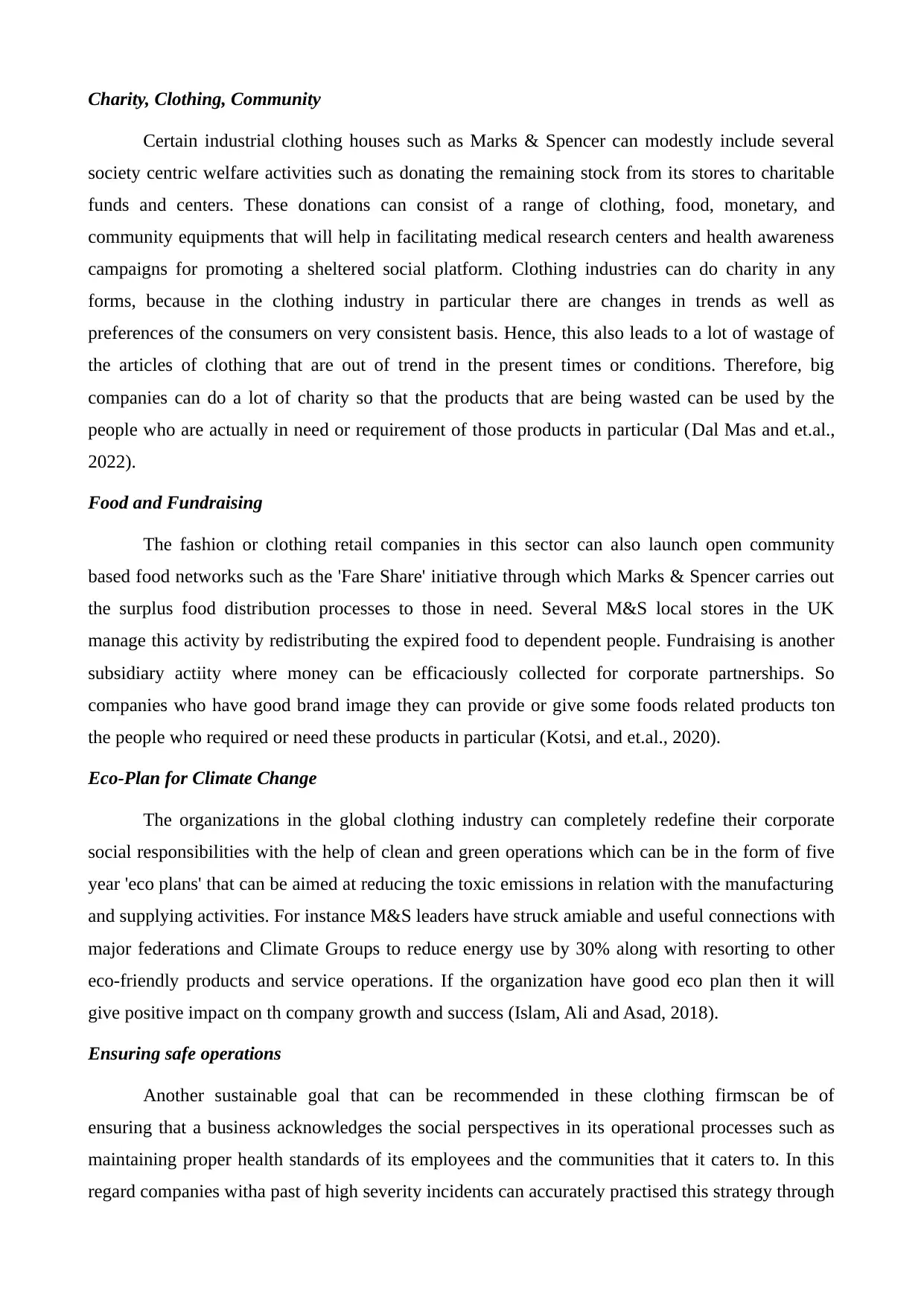
Charity, Clothing, Community
Certain industrial clothing houses such as Marks & Spencer can modestly include several
society centric welfare activities such as donating the remaining stock from its stores to charitable
funds and centers. These donations can consist of a range of clothing, food, monetary, and
community equipments that will help in facilitating medical research centers and health awareness
campaigns for promoting a sheltered social platform. Clothing industries can do charity in any
forms, because in the clothing industry in particular there are changes in trends as well as
preferences of the consumers on very consistent basis. Hence, this also leads to a lot of wastage of
the articles of clothing that are out of trend in the present times or conditions. Therefore, big
companies can do a lot of charity so that the products that are being wasted can be used by the
people who are actually in need or requirement of those products in particular (Dal Mas and et.al.,
2022).
Food and Fundraising
The fashion or clothing retail companies in this sector can also launch open community
based food networks such as the 'Fare Share' initiative through which Marks & Spencer carries out
the surplus food distribution processes to those in need. Several M&S local stores in the UK
manage this activity by redistributing the expired food to dependent people. Fundraising is another
subsidiary actiity where money can be efficaciously collected for corporate partnerships. So
companies who have good brand image they can provide or give some foods related products ton
the people who required or need these products in particular (Kotsi, and et.al., 2020).
Eco-Plan for Climate Change
The organizations in the global clothing industry can completely redefine their corporate
social responsibilities with the help of clean and green operations which can be in the form of five
year 'eco plans' that can be aimed at reducing the toxic emissions in relation with the manufacturing
and supplying activities. For instance M&S leaders have struck amiable and useful connections with
major federations and Climate Groups to reduce energy use by 30% along with resorting to other
eco-friendly products and service operations. If the organization have good eco plan then it will
give positive impact on th company growth and success (Islam, Ali and Asad, 2018).
Ensuring safe operations
Another sustainable goal that can be recommended in these clothing firmscan be of
ensuring that a business acknowledges the social perspectives in its operational processes such as
maintaining proper health standards of its employees and the communities that it caters to. In this
regard companies witha past of high severity incidents can accurately practised this strategy through
Certain industrial clothing houses such as Marks & Spencer can modestly include several
society centric welfare activities such as donating the remaining stock from its stores to charitable
funds and centers. These donations can consist of a range of clothing, food, monetary, and
community equipments that will help in facilitating medical research centers and health awareness
campaigns for promoting a sheltered social platform. Clothing industries can do charity in any
forms, because in the clothing industry in particular there are changes in trends as well as
preferences of the consumers on very consistent basis. Hence, this also leads to a lot of wastage of
the articles of clothing that are out of trend in the present times or conditions. Therefore, big
companies can do a lot of charity so that the products that are being wasted can be used by the
people who are actually in need or requirement of those products in particular (Dal Mas and et.al.,
2022).
Food and Fundraising
The fashion or clothing retail companies in this sector can also launch open community
based food networks such as the 'Fare Share' initiative through which Marks & Spencer carries out
the surplus food distribution processes to those in need. Several M&S local stores in the UK
manage this activity by redistributing the expired food to dependent people. Fundraising is another
subsidiary actiity where money can be efficaciously collected for corporate partnerships. So
companies who have good brand image they can provide or give some foods related products ton
the people who required or need these products in particular (Kotsi, and et.al., 2020).
Eco-Plan for Climate Change
The organizations in the global clothing industry can completely redefine their corporate
social responsibilities with the help of clean and green operations which can be in the form of five
year 'eco plans' that can be aimed at reducing the toxic emissions in relation with the manufacturing
and supplying activities. For instance M&S leaders have struck amiable and useful connections with
major federations and Climate Groups to reduce energy use by 30% along with resorting to other
eco-friendly products and service operations. If the organization have good eco plan then it will
give positive impact on th company growth and success (Islam, Ali and Asad, 2018).
Ensuring safe operations
Another sustainable goal that can be recommended in these clothing firmscan be of
ensuring that a business acknowledges the social perspectives in its operational processes such as
maintaining proper health standards of its employees and the communities that it caters to. In this
regard companies witha past of high severity incidents can accurately practised this strategy through
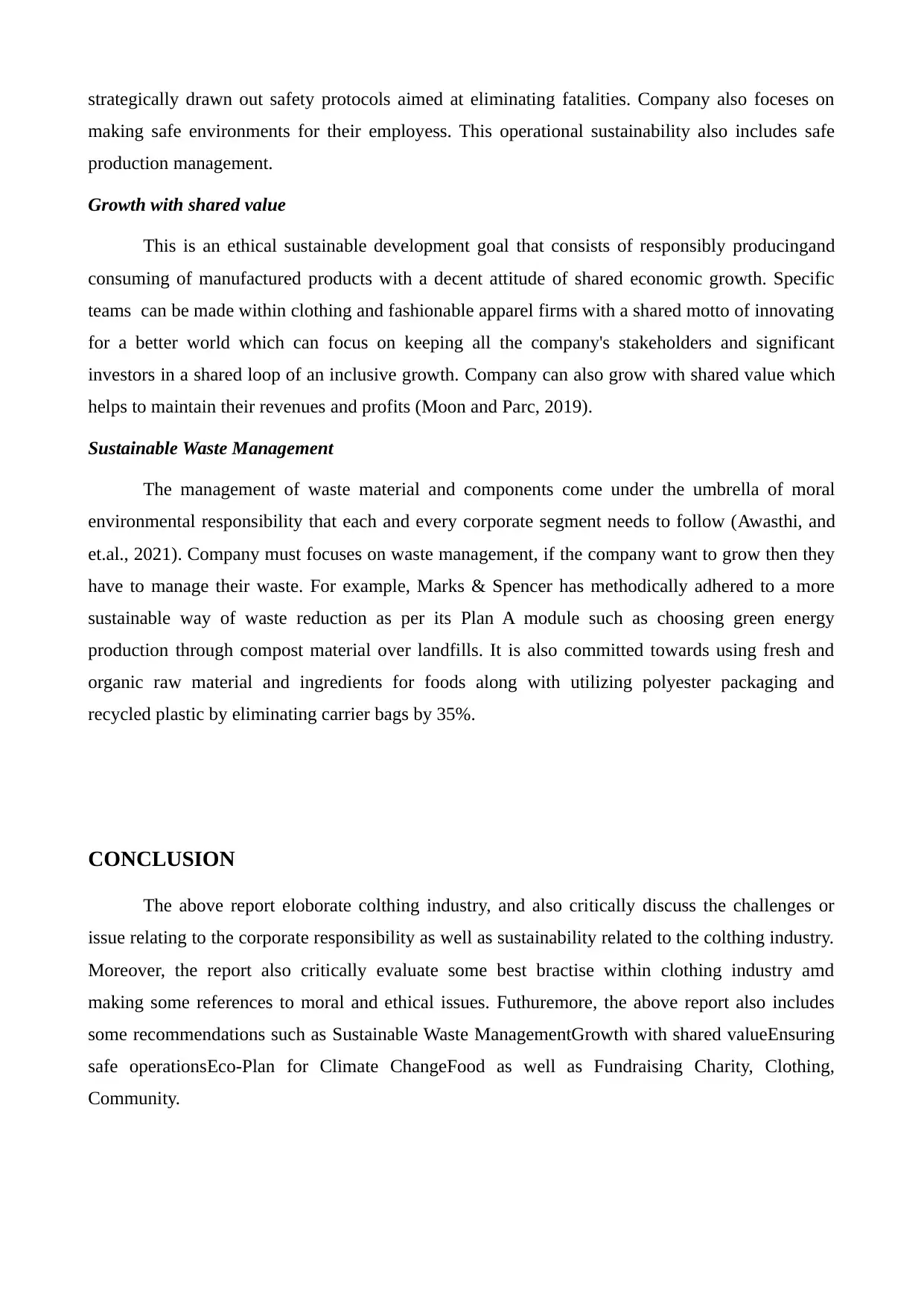
strategically drawn out safety protocols aimed at eliminating fatalities. Company also foceses on
making safe environments for their employess. This operational sustainability also includes safe
production management.
Growth with shared value
This is an ethical sustainable development goal that consists of responsibly producingand
consuming of manufactured products with a decent attitude of shared economic growth. Specific
teams can be made within clothing and fashionable apparel firms with a shared motto of innovating
for a better world which can focus on keeping all the company's stakeholders and significant
investors in a shared loop of an inclusive growth. Company can also grow with shared value which
helps to maintain their revenues and profits (Moon and Parc, 2019).
Sustainable Waste Management
The management of waste material and components come under the umbrella of moral
environmental responsibility that each and every corporate segment needs to follow (Awasthi, and
et.al., 2021). Company must focuses on waste management, if the company want to grow then they
have to manage their waste. For example, Marks & Spencer has methodically adhered to a more
sustainable way of waste reduction as per its Plan A module such as choosing green energy
production through compost material over landfills. It is also committed towards using fresh and
organic raw material and ingredients for foods along with utilizing polyester packaging and
recycled plastic by eliminating carrier bags by 35%.
CONCLUSION
The above report eloborate colthing industry, and also critically discuss the challenges or
issue relating to the corporate responsibility as well as sustainability related to the colthing industry.
Moreover, the report also critically evaluate some best bractise within clothing industry amd
making some references to moral and ethical issues. Futhuremore, the above report also includes
some recommendations such as Sustainable Waste ManagementGrowth with shared valueEnsuring
safe operationsEco-Plan for Climate ChangeFood as well as Fundraising Charity, Clothing,
Community.
making safe environments for their employess. This operational sustainability also includes safe
production management.
Growth with shared value
This is an ethical sustainable development goal that consists of responsibly producingand
consuming of manufactured products with a decent attitude of shared economic growth. Specific
teams can be made within clothing and fashionable apparel firms with a shared motto of innovating
for a better world which can focus on keeping all the company's stakeholders and significant
investors in a shared loop of an inclusive growth. Company can also grow with shared value which
helps to maintain their revenues and profits (Moon and Parc, 2019).
Sustainable Waste Management
The management of waste material and components come under the umbrella of moral
environmental responsibility that each and every corporate segment needs to follow (Awasthi, and
et.al., 2021). Company must focuses on waste management, if the company want to grow then they
have to manage their waste. For example, Marks & Spencer has methodically adhered to a more
sustainable way of waste reduction as per its Plan A module such as choosing green energy
production through compost material over landfills. It is also committed towards using fresh and
organic raw material and ingredients for foods along with utilizing polyester packaging and
recycled plastic by eliminating carrier bags by 35%.
CONCLUSION
The above report eloborate colthing industry, and also critically discuss the challenges or
issue relating to the corporate responsibility as well as sustainability related to the colthing industry.
Moreover, the report also critically evaluate some best bractise within clothing industry amd
making some references to moral and ethical issues. Futhuremore, the above report also includes
some recommendations such as Sustainable Waste ManagementGrowth with shared valueEnsuring
safe operationsEco-Plan for Climate ChangeFood as well as Fundraising Charity, Clothing,
Community.
Secure Best Marks with AI Grader
Need help grading? Try our AI Grader for instant feedback on your assignments.
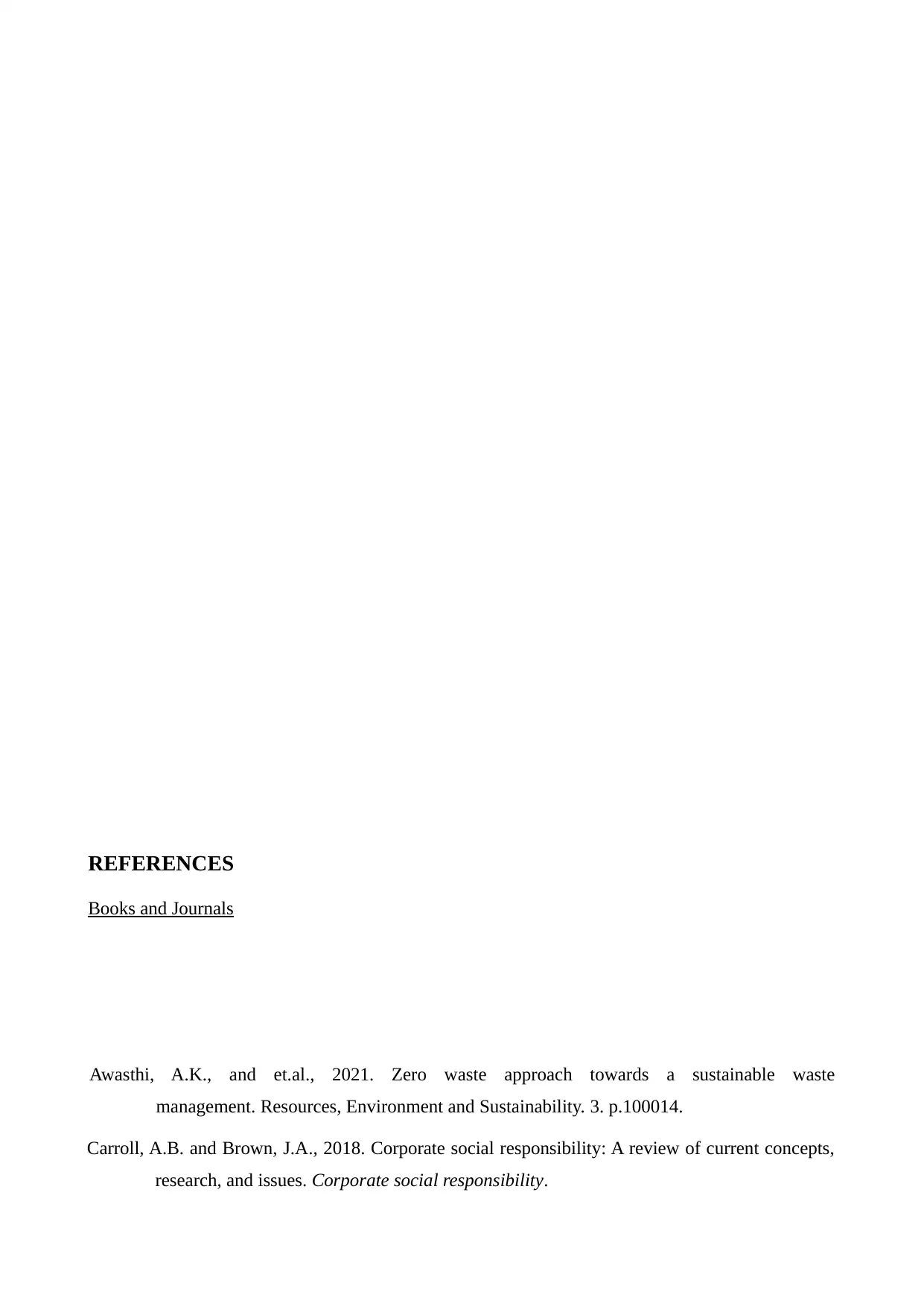
REFERENCES
Books and Journals
Awasthi, A.K., and et.al., 2021. Zero waste approach towards a sustainable waste
management. Resources, Environment and Sustainability. 3. p.100014.
Carroll, A.B. and Brown, J.A., 2018. Corporate social responsibility: A review of current concepts,
research, and issues. Corporate social responsibility.
Books and Journals
Awasthi, A.K., and et.al., 2021. Zero waste approach towards a sustainable waste
management. Resources, Environment and Sustainability. 3. p.100014.
Carroll, A.B. and Brown, J.A., 2018. Corporate social responsibility: A review of current concepts,
research, and issues. Corporate social responsibility.
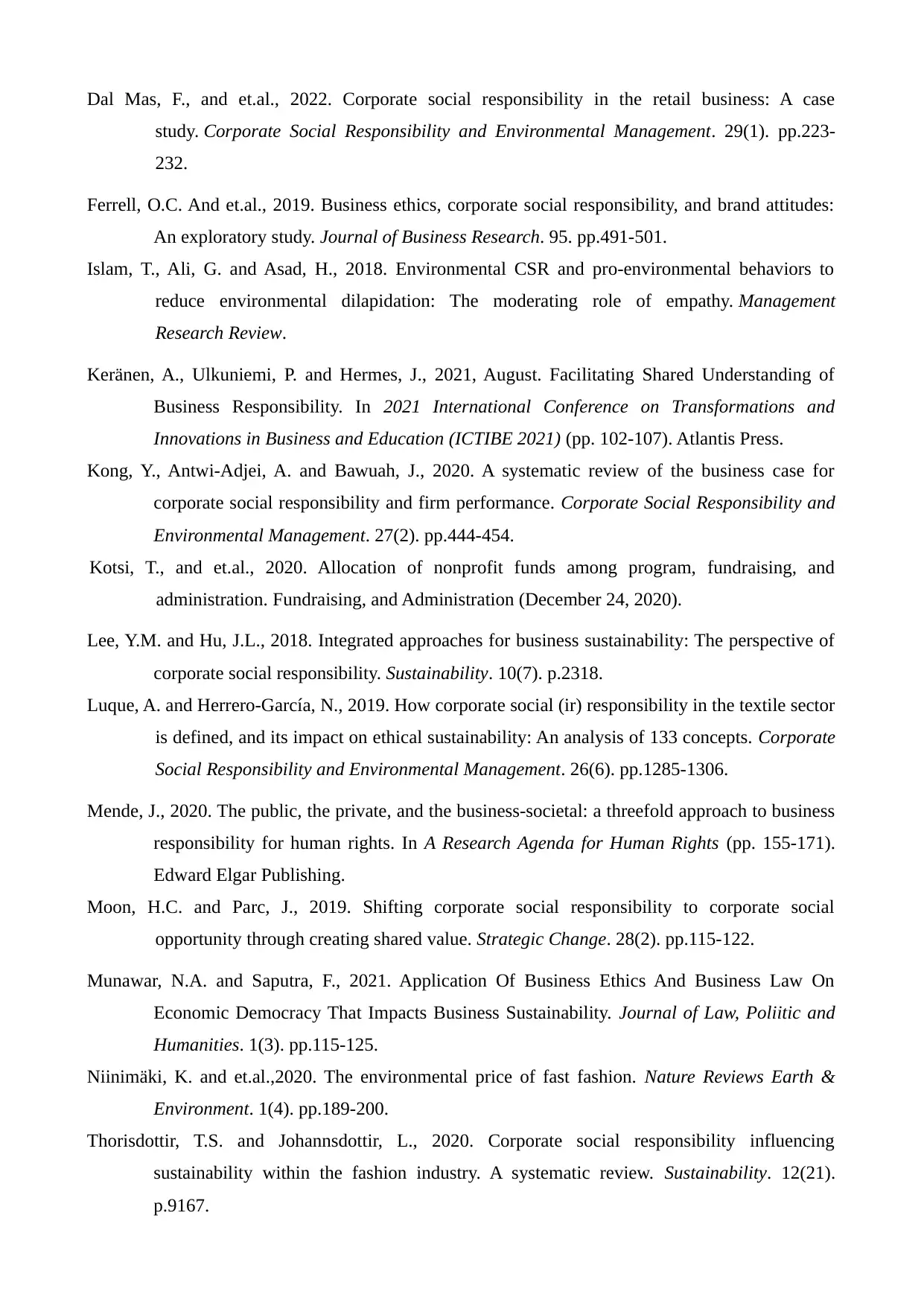
Dal Mas, F., and et.al., 2022. Corporate social responsibility in the retail business: A case
study. Corporate Social Responsibility and Environmental Management. 29(1). pp.223-
232.
Ferrell, O.C. And et.al., 2019. Business ethics, corporate social responsibility, and brand attitudes:
An exploratory study. Journal of Business Research. 95. pp.491-501.
Islam, T., Ali, G. and Asad, H., 2018. Environmental CSR and pro-environmental behaviors to
reduce environmental dilapidation: The moderating role of empathy. Management
Research Review.
Keränen, A., Ulkuniemi, P. and Hermes, J., 2021, August. Facilitating Shared Understanding of
Business Responsibility. In 2021 International Conference on Transformations and
Innovations in Business and Education (ICTIBE 2021) (pp. 102-107). Atlantis Press.
Kong, Y., Antwi‐Adjei, A. and Bawuah, J., 2020. A systematic review of the business case for
corporate social responsibility and firm performance. Corporate Social Responsibility and
Environmental Management. 27(2). pp.444-454.
Kotsi, T., and et.al., 2020. Allocation of nonprofit funds among program, fundraising, and
administration. Fundraising, and Administration (December 24, 2020).
Lee, Y.M. and Hu, J.L., 2018. Integrated approaches for business sustainability: The perspective of
corporate social responsibility. Sustainability. 10(7). p.2318.
Luque, A. and Herrero‐García, N., 2019. How corporate social (ir) responsibility in the textile sector
is defined, and its impact on ethical sustainability: An analysis of 133 concepts. Corporate
Social Responsibility and Environmental Management. 26(6). pp.1285-1306.
Mende, J., 2020. The public, the private, and the business-societal: a threefold approach to business
responsibility for human rights. In A Research Agenda for Human Rights (pp. 155-171).
Edward Elgar Publishing.
Moon, H.C. and Parc, J., 2019. Shifting corporate social responsibility to corporate social
opportunity through creating shared value. Strategic Change. 28(2). pp.115-122.
Munawar, N.A. and Saputra, F., 2021. Application Of Business Ethics And Business Law On
Economic Democracy That Impacts Business Sustainability. Journal of Law, Poliitic and
Humanities. 1(3). pp.115-125.
Niinimäki, K. and et.al.,2020. The environmental price of fast fashion. Nature Reviews Earth &
Environment. 1(4). pp.189-200.
Thorisdottir, T.S. and Johannsdottir, L., 2020. Corporate social responsibility influencing
sustainability within the fashion industry. A systematic review. Sustainability. 12(21).
p.9167.
study. Corporate Social Responsibility and Environmental Management. 29(1). pp.223-
232.
Ferrell, O.C. And et.al., 2019. Business ethics, corporate social responsibility, and brand attitudes:
An exploratory study. Journal of Business Research. 95. pp.491-501.
Islam, T., Ali, G. and Asad, H., 2018. Environmental CSR and pro-environmental behaviors to
reduce environmental dilapidation: The moderating role of empathy. Management
Research Review.
Keränen, A., Ulkuniemi, P. and Hermes, J., 2021, August. Facilitating Shared Understanding of
Business Responsibility. In 2021 International Conference on Transformations and
Innovations in Business and Education (ICTIBE 2021) (pp. 102-107). Atlantis Press.
Kong, Y., Antwi‐Adjei, A. and Bawuah, J., 2020. A systematic review of the business case for
corporate social responsibility and firm performance. Corporate Social Responsibility and
Environmental Management. 27(2). pp.444-454.
Kotsi, T., and et.al., 2020. Allocation of nonprofit funds among program, fundraising, and
administration. Fundraising, and Administration (December 24, 2020).
Lee, Y.M. and Hu, J.L., 2018. Integrated approaches for business sustainability: The perspective of
corporate social responsibility. Sustainability. 10(7). p.2318.
Luque, A. and Herrero‐García, N., 2019. How corporate social (ir) responsibility in the textile sector
is defined, and its impact on ethical sustainability: An analysis of 133 concepts. Corporate
Social Responsibility and Environmental Management. 26(6). pp.1285-1306.
Mende, J., 2020. The public, the private, and the business-societal: a threefold approach to business
responsibility for human rights. In A Research Agenda for Human Rights (pp. 155-171).
Edward Elgar Publishing.
Moon, H.C. and Parc, J., 2019. Shifting corporate social responsibility to corporate social
opportunity through creating shared value. Strategic Change. 28(2). pp.115-122.
Munawar, N.A. and Saputra, F., 2021. Application Of Business Ethics And Business Law On
Economic Democracy That Impacts Business Sustainability. Journal of Law, Poliitic and
Humanities. 1(3). pp.115-125.
Niinimäki, K. and et.al.,2020. The environmental price of fast fashion. Nature Reviews Earth &
Environment. 1(4). pp.189-200.
Thorisdottir, T.S. and Johannsdottir, L., 2020. Corporate social responsibility influencing
sustainability within the fashion industry. A systematic review. Sustainability. 12(21).
p.9167.

Yuan, Y. and et.al., 2020. Business strategy and corporate social responsibility. Journal of Business
Ethics. 162(2). pp.359-377.
Ethics. 162(2). pp.359-377.
1 out of 13
Related Documents
Your All-in-One AI-Powered Toolkit for Academic Success.
+13062052269
info@desklib.com
Available 24*7 on WhatsApp / Email
![[object Object]](/_next/static/media/star-bottom.7253800d.svg)
Unlock your academic potential
© 2024 | Zucol Services PVT LTD | All rights reserved.



